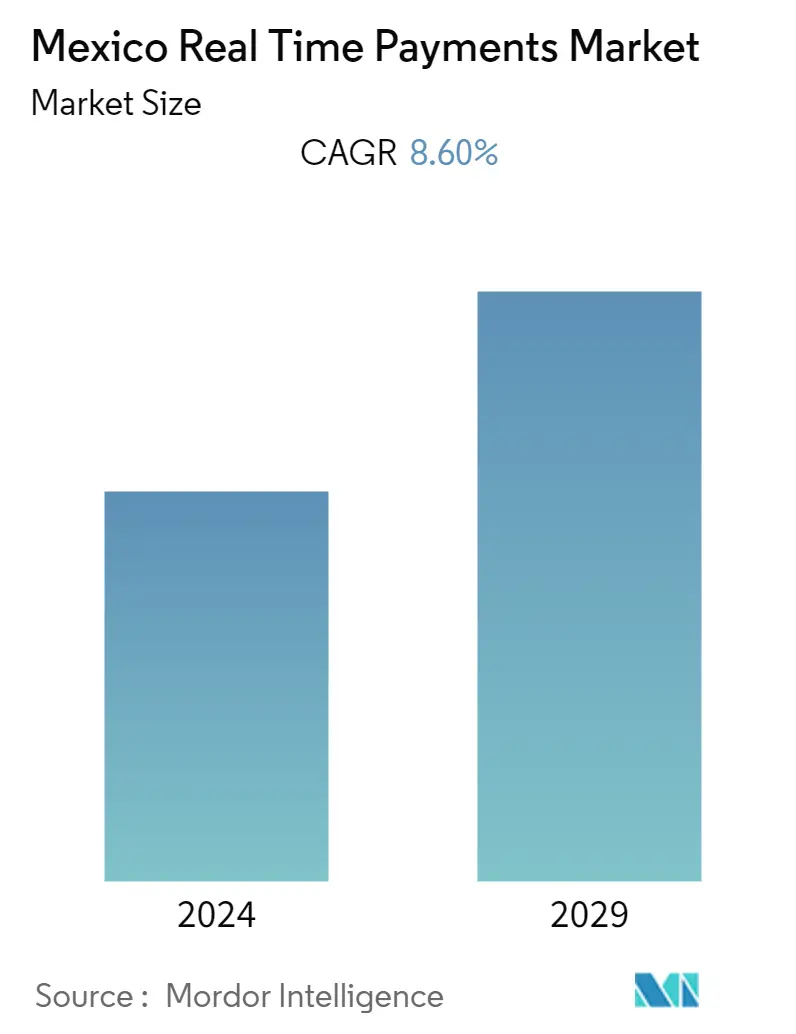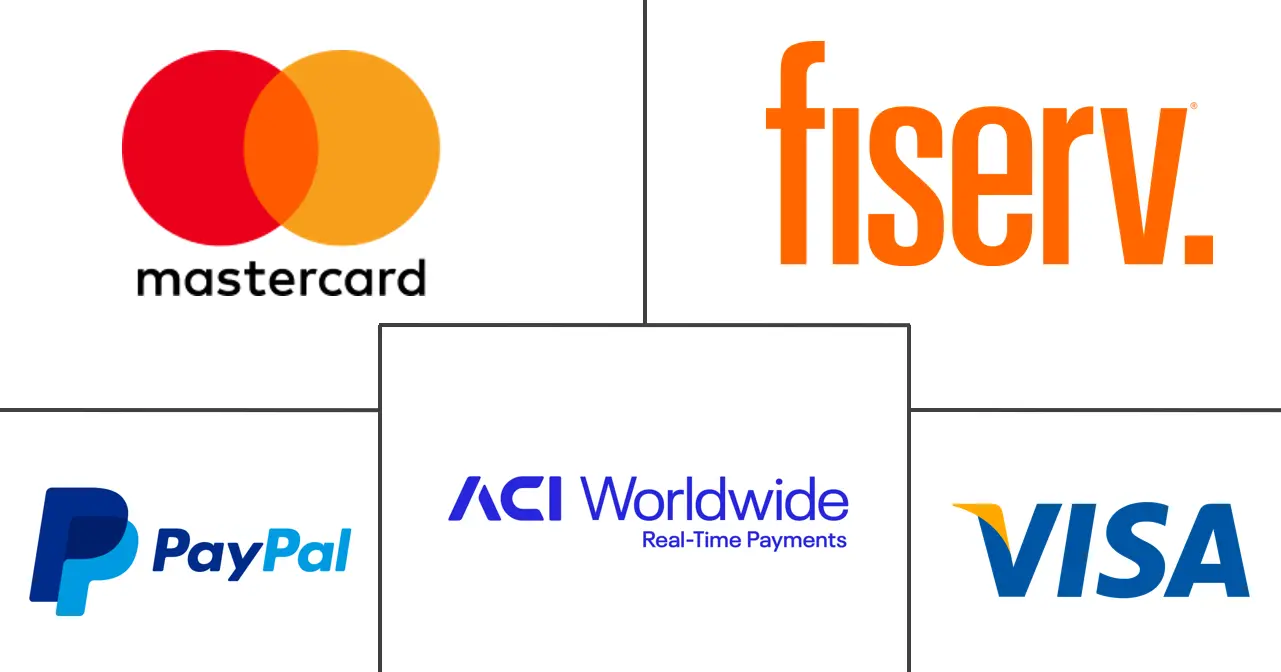Market Size of Mexico Real Time Payments Industry

| Study Period | 2019 - 2029 |
| Base Year For Estimation | 2023 |
| Forecast Data Period | 2024 - 2029 |
| Historical Data Period | 2019 - 2022 |
| CAGR | 8.60 % |
| Market Concentration | Low |
Major Players
*Disclaimer: Major Players sorted in no particular order |
Mexico Real-Time Payment Market Analysis
Mexico Real-time payment market is expected to have significant growth of 8.6% for the forecast period of 2022-2027. The country is witnessing significant adoption of digital payments, and the country has been reporting increased activities in real time payments due to the expanded usage of smartphones in the country, along with the growing need to go for a cashless economy.
- Mexico introduced the Sistema de Pagos Electrónicos Interbancarios (SPEI) system in 2004 and adopted real-time payments early on. Despite the early start, the adoption of real-time payments has grown slower due to the large population without national bank accounts and lack of awareness of electronic payments. However, with the release of Cobro Digital (CoDi) in September 2019, the use of real-time payments has expanded to low-value, recurring payments, and the growth of real-time payments has gained some traction in recent years through QR code and NFC technology.
- The credit card market in Mexico has grown in terms of the number of cards in circulation and transaction value and quantity, supported by high consumer spending. To cater to the high-potential credit card market, digital-only card issuers have entered the space.
- Mexico's government focuses on financial inclusion by undertaking three social benefits programs: Oportunidades, Programa para Adultos Mayores and Procampo, disbursing benefits through bank accounts and cards. In addition, alternative payments, including PayPal, MercadoPago, DineroMail, and SafetyPay, are all used extensively for online shopping. The availability of digital wallet services, and the security and convenience they provide, have made them popular among consumers.
- The growth of e-commerce is expected to create opportunities in Mexico. For instance, According to WorldPay, the e-commerce revenue was estimated at USD 32 billion in 2021. E-commerce revenue generated from mobile devices is anticipated to increase significantly by 2022. The growing penetration of smartphones would further augment the market's growth.
- Many Mexicans are buying online owing to the COVID-19 outbreak. According to the general director of the Mexican Association of Online Sales, the pandemic has served as a kind of a turning point for e-commerce in the country. According to Latin American e-commerce giant Mercado Libre, between March 12 and 19, online sales of household items such as cleaning detergents skyrocketed 400%, and pharmaceutical items jumped 114%.
Mexico Real-Time Payment Industry Segmentation
Real-time payments or RTP are payments that are begun and settled nearly immediately. It is the digital infrastructure that facilitates real-time payments. Ideally, real-time payment networks provide 24x7x365 access, which means they are always online to process transfers at any given day or time.
The Mexico Real Time Payments Market is segmented By Type of payment (P2P and P2B).
| By Type of Payment | |
| P2P | |
| P2B |
Mexico Real Time Payments Market Size Summary
The Mexico real-time payment market is experiencing robust growth, driven by the increasing adoption of digital payments and the widespread use of smartphones. The introduction of the Sistema de Pagos Electrónicos Interbancarios (SPEI) system in 2004 marked Mexico's early entry into real-time payments, but growth was initially slow due to a significant portion of the population lacking bank accounts and awareness. However, the launch of Cobro Digital (CoDi) in 2019 has accelerated the adoption of real-time payments, particularly for low-value, recurring transactions, leveraging QR code and NFC technology. The credit card market has also expanded, supported by digital-only issuers catering to high consumer spending. The government's focus on financial inclusion through social benefit programs and the rise of alternative payment methods like PayPal and MercadoPago have further bolstered the market. The growth of e-commerce, accelerated by the COVID-19 pandemic, has created additional opportunities, with mobile device transactions expected to rise significantly.
Mexico's real-time payment market is poised for continued expansion, supported by strategic investments and partnerships aimed at enhancing the digital payment infrastructure. The government's efforts to foster competition among public and private enterprises are intended to reduce costs for low-income individuals and promote a cashless economy. Significant investments, such as Clip's capital raise, have positioned key players as leaders in the market, while collaborations like those between Whale Cloud and Toka Fintech aim to improve access to inclusive financial services. The increasing number of cashless transactions and the growing demand in the retail sector are driving companies to engage in strategic activities, such as Mastercard's acquisition of Arcus FI, to enhance real-time payment solutions. The market's attractiveness has led to fragmentation due to new entrants, with service providers focusing on product innovation and partnerships to capture the growing consumer base.
Mexico Real Time Payments Market Size - Table of Contents
-
1. MARKET INSIGHTS
-
1.1 Market Overview
-
1.2 Industry Attractiveness - Porter's Five Forces Analysis
-
1.2.1 Bargaining Power of Suppliers
-
1.2.2 Bargaining Power of Consumers
-
1.2.3 Threat of New Entrants
-
1.2.4 Threat of Substitute Products
-
1.2.5 Intensity of Competitive Rivalry
-
-
1.3 Evolution of the payments landscape in the country
-
1.4 Key market trends pertaining to the growth of cashless transaction in the country
-
1.5 Assessment of COVID-19 Impact on the Market
-
-
2. MARKET SEGMENTATION
-
2.1 By Type of Payment
-
2.1.1 P2P
-
2.1.2 P2B
-
-
Mexico Real Time Payments Market Size FAQs
What is the current Mexico Real Time Payments Market size?
The Mexico Real Time Payments Market is projected to register a CAGR of 8.60% during the forecast period (2024-2029)
Who are the key players in Mexico Real Time Payments Market?
ACI Worldwide, Inc, Mastercard, Inc, PayPal Holdings, Inc, Visa Inc and Fiserve are the major companies operating in the Mexico Real Time Payments Market.

